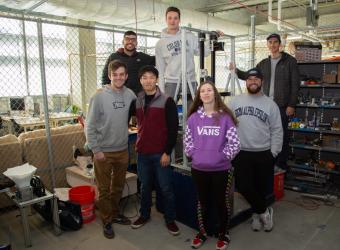Mines students qualify for 2020 NASA Moon to Mars Ice & Prospecting Challenge

Students from Colorado School of Mines are headed to NASA’s Langley Research Center this summer for a competition that is out of this world.
Who can extract the most water from a simulated slice of the Martian or lunar surface?
The 2020 NASA RASC-AL Special Edition: Moon to Mars Ice & Prospecting Challenge will pit 10 university teams from across the nation in an on-site competition June 1-4 to find out.
Team DREAMR – short for Drilling Rig for the Exploration and Acquisition of Martian Resources – is the fourth Mines team in four years to qualify for the one-of-a-kind collegiate aerospace competition.
“Extracting water from deep space environments, it’s one of the biggest challenges we’re facing looking into the future. Anything we can do to contribute is really important,” said Tyler Baack, a senior majoring in mechanical engineering. “NASA is looking for original ideas.”

The all-mechanical engineering team has wasted no time in getting started remaking last year’s Mines rig into their own – the team stripped out and replaced all the electrical and control systems over winter break shortly after learning they qualified for the finals.
“Our focus this year is on automation,” Baack said. “The system is going to need to be able to make decisions on its own. In deep space environments, we can’t have an operator. Say there’s a 15-minute lag time. If the drill encounters a problem, the rig needs to deal with that on its own.”
In addition to adding a programmable logic controller, the team is also planning to integrate a heat exchanger into the drilling and extraction subsystem, tapping into the power of forced convection in hopes of increasing the amount of water they can ultimately pull out.
“You really have to utilize the power you have. The idea of a heat exchanger is just trying to maximize that, to make sure we’re not letting all this power we’re putting into it go to waste,” said Matthew Krist, a senior majoring in mechanical engineering. “If we’re already extracting water, why don’t we utilize some of it and actually take that hot water, put it back down the hole to help melt as much ice as possible? It’s something a Mines team hasn’t tried before.”
Rounding out this year’s Mines team are Sean Cummins, Joel Gomez, Alison Kakos, Joseph Kusbel and Sahro Seong.
“Coming up with something new and innovative is definitely the goal,” Krist said. “What’s really cool about this project is there are so many different systems and subsystems that have to come together, whether it’s mechanical, heat extraction, the drilling system, and you’re also trying to make everything as automated as possible.”
The Moon to Mars Ice & Prospecting Challenge is a special edition of NASA’s Revolutionary Aerospace Systems Concepts – Academic Linkage (RASC-AL), a series of university-level engineering design competitions sponsored by NASA and managed by the National Institute of Aerospace to engage students and faculty in real-world aerospace work.
The other teams competing in the June finals hail from Cal Poly, MIT, Northeastern, Stevens Institute of Technology, Texas A&M, University of Tennessee, USC, University of Virginia and Virginia Tech.




